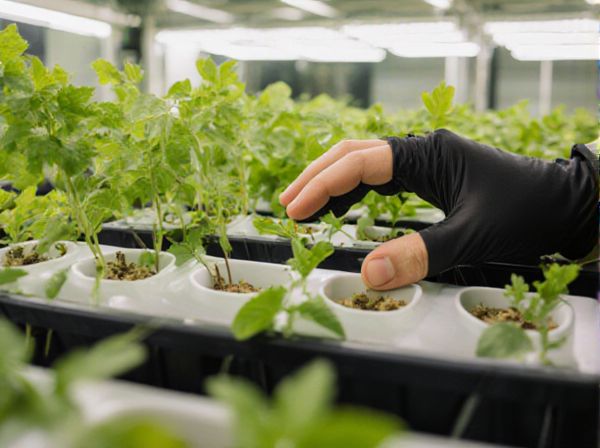
Aeroponic vs Aquaponic Illustration
Aeroponic systems deliver nutrients through a mist directly to plant roots, maximizing oxygen exposure and promoting rapid growth with minimal water usage. Aquaponic systems combine fish farming with hydroponics, creating a symbiotic environment where fish waste provides essential nutrients for plants, enhancing sustainability and reducing chemical fertilizers. Both techniques optimize resource efficiency but differ in nutrient delivery methods and ecosystem integration.
Table of Comparison
| Feature | Aeroponic | Aquaponic |
|---|---|---|
| Growing Method | Plants suspended; roots misted with nutrient-rich water | Plants grown in water with nutrient-rich fish waste |
| System Components | Misting system, growth chamber, nutrient solution | Fish tank, biofilter, grow beds |
| Water Efficiency | High, uses 90% less water than traditional soil | Efficient; recycles fish waste with minimal water loss |
| Plant Growth Rate | Very fast due to high oxygen exposure | Fast, enhanced by natural nutrients from fish |
| Maintenance | Requires precise misting and monitoring | Needs fish care and water quality management |
| Cost | Higher initial investment for equipment | Moderate; includes fish system setup |
| Ideal For | High-density, high-tech farming, research | Integrated fish and plant farming, sustainable food production |
Introduction to Aeroponic and Aquaponic Systems
Aeroponic systems suspend plant roots in air and mist them with a nutrient-rich solution, promoting oxygen exposure and rapid growth, while aquaponic systems combine hydroponics with aquaculture by circulating nutrient-enriched water from fish tanks to plants. Aeroponics offers precise nutrient control and efficient water use, making it ideal for high-density urban farming. Aquaponics creates a sustainable ecosystem by recycling fish waste as natural fertilizer, integrating fish production with crop cultivation for enhanced resource efficiency.
Core Principles: How Aeroponics and Aquaponics Work
Aeroponics utilizes a misting system to deliver nutrient-rich water directly to plant roots suspended in air, maximizing oxygen exposure and accelerating growth. Aquaponics combines hydroponics with aquaculture, cycling nutrient-rich water from fish tanks to nourish plants while bacteria convert fish waste into usable nutrients. Both systems optimize water use and nutrient delivery but differ by leveraging air misting versus integrated aquatic ecosystems for plant cultivation.
Equipment and Setup Requirements
Aeroponic systems require misting nozzles, high-pressure pumps, and enclosed chambers to deliver nutrient-rich mist directly to plant roots, demanding precise control of humidity and air circulation. Aquaponic setups combine hydroponic grow beds with fish tanks, necessitating pumps, biofilters, and plumbing to manage water flow and maintain balanced ecosystems between aquatic animals and plants. The complexity of aquaponic equipment is higher due to biological components, while aeroponic systems focus more on advanced misting technology and airtight, aerated root environments.
Nutrient Delivery Methods Compared
Aeroponic systems deliver nutrients by misting plant roots with a nutrient-rich solution, allowing for maximum oxygen exposure and rapid nutrient absorption. Aquaponic systems combine fish farming with hydroponics, where nutrient delivery relies on fish waste converted by bacteria into fertilizers circulated through the plant roots. Aeroponics typically offers more precise control over nutrient concentrations and oxygen levels, while aquaponics provides a sustainable nutrient cycle through natural biofiltration.
Water Usage and Sustainability
Aeroponic systems use up to 95% less water than traditional soil farming by misting plant roots, maximizing water efficiency and minimizing waste. Aquaponic systems combine fish farming with plant cultivation, recycling water between fish tanks and grow beds to create a closed-loop system that conserves water while producing protein and crops. Both methods significantly reduce water consumption compared to conventional agriculture, but aeroponics excels in water savings, whereas aquaponics enhances sustainability through nutrient recycling and integrated food production.
Ideal Crops for Aeroponics vs Aquaponics
Aeroponic systems excel in cultivating leafy greens like lettuce, spinach, and herbs due to their high oxygen availability and precise nutrient delivery. Aquaponic setups are ideal for growing fruiting crops such as tomatoes, peppers, and cucumbers, benefiting from the symbiotic relationship between fish and plants that enriches nutrient content. These distinctions in crop suitability arise from aeroponics' mist-based root environment versus aquaponics' integrated fish and plant ecosystem.
Maintenance and System Care
Aeroponic systems require regular cleaning of misters and monitoring of nutrient solution spray to prevent clogging and ensure optimal oxygen delivery to plant roots. Aquaponic systems demand consistent balancing of aquatic life health with plant nutrient needs, including monitoring water quality parameters such as pH, ammonia, and nitrite levels to maintain a healthy symbiotic environment. Both systems benefit from routine inspections, yet aeroponics typically involves more frequent mechanical maintenance, whereas aquaponics necessitates specialized care for fish and biofilter components.
Cost Analysis: Initial and Ongoing Expenses
Aeroponic systems typically require higher initial investments due to advanced misting technology and precise environmental controls, while aquaponic setups often involve moderate startup costs related to fish tanks and biofiltration units. Ongoing expenses for aeroponics include maintenance of pumps and nozzles to prevent clogging, whereas aquaponics incurs costs for fish feed, water quality management, and occasional system balancing. Both systems offer cost-efficiency in water usage compared to traditional agriculture, but aquaponics may present additional labor and resource costs linked to integrated aquaculture care.
Common Challenges and Solutions
Aeroponic systems often face issues with root drying and pump failures, which can be mitigated through regular maintenance and backup power supplies. Aquaponic setups commonly struggle with balancing fish health and plant nutrient needs, resolved by monitoring water quality parameters like pH, ammonia, and nitrite levels consistently. Both systems benefit from automation technologies to optimize environmental control and reduce manual intervention.
Choosing the Right System for Your Gardening Goals
Aeroponic systems deliver nutrient-rich mist directly to plant roots, maximizing oxygen exposure and promoting rapid growth, ideal for growers seeking high yields in limited space. Aquaponic setups combine aquaculture with hydroponics by using fish waste to naturally fertilize plants, creating a sustainable ecosystem suited for those interested in integrating fish production with crop cultivation. Selecting the right system depends on factors like desired crop type, resource availability, maintenance commitment, and long-term sustainability goals.
Aeroponic vs Aquaponic Infographic

 gardendif.com
gardendif.com